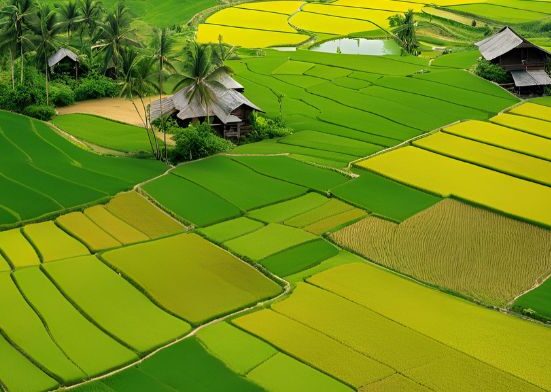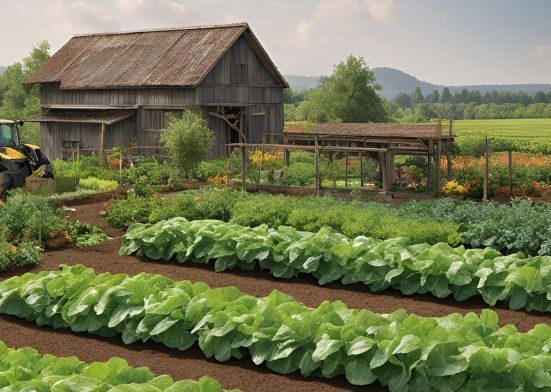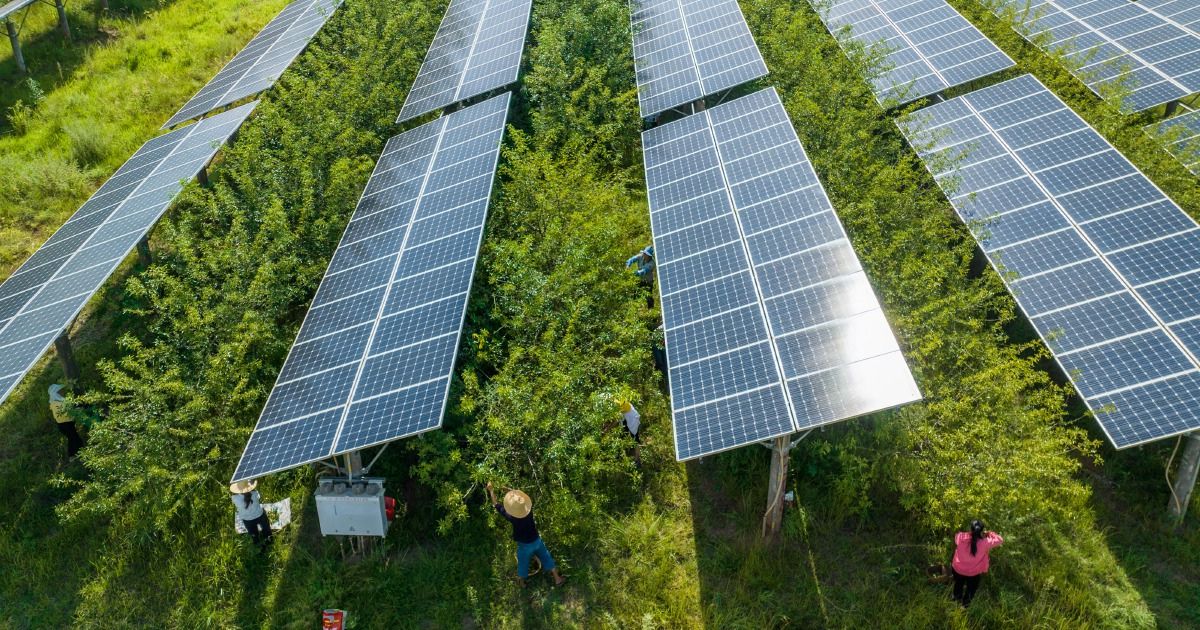As the Global Population surges toward 10 billion by 2050, the demand for sustainable food and energy production has never been more pressing. Traditional agriculture faces challenges like land scarcity, water shortages, and climate change, while the energy sector grapples with the need to transition to renewables without sacrificing arable land. Enter agrivoltaics, the innovative practice of co-locating solar panels and crops on the same land. Farming under solar panels can address food security, renewable energy goals, and environmental sustainability in one fell swoop. This 3,000-word exploration delves into agrivoltaics’ science, benefits, challenges, and future potential, painting a vivid picture of a bright future for agriculture.
What is Agrivoltaics?
Agrivoltaics, a portmanteau of “agriculture” and “photovoltaics,” refers to the dual use of land for solar energy production and crop cultivation. Solar panels are installed above or alongside crops, creating a shared ecosystem where both systems thrive. The concept emerged in the early 1980s when German scientist Adolf Goetzberger proposed that partial shading from solar panels could benefit certain crops. Since then, research and real-world applications have exploded, particularly in regions like Europe, Asia, and North robotics and agriculture America.
The setup varies depending on the region, climate, and crop type. In some systems, solar panels are mounted high enough to allow farming equipment to pass underneath. In other panels, the panels are spaced to optimize sunlight for crops. The panels can be fixed or adjustable, tilting to balance light distribution between energy generation and plant growth. This synergy creates a microclimate that can enhance crop yields, conserve water, and generate clean energy—all on the same plot of solar panel farm land.
The Science Behind Agrivoltaics
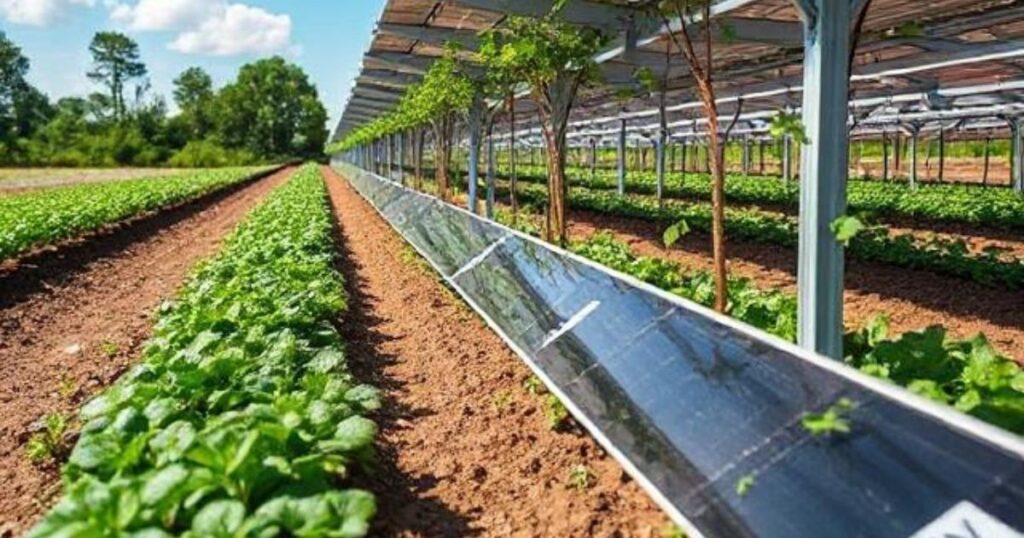 Agrivoltaics is an innovative approach that combines agriculture and solar energy production on the same land, offering a solution to land-use competition between food and energy. The science behind agrivoltaics revolves around the strategic placement of photovoltaic (PV) panels above crops to create a microclimate that benefits both plant growth and energy yield. These elevated solar panels provide partial shade, which can reduce heat stress and water evaporation from the soil, improving crop resilience, especially in arid regions. At the same time, plants can cool the environment beneath the panels through transpiration, enhancing the efficiency of solar cells, which typically perform better at lower temperatures.
Agrivoltaics is an innovative approach that combines agriculture and solar energy production on the same land, offering a solution to land-use competition between food and energy. The science behind agrivoltaics revolves around the strategic placement of photovoltaic (PV) panels above crops to create a microclimate that benefits both plant growth and energy yield. These elevated solar panels provide partial shade, which can reduce heat stress and water evaporation from the soil, improving crop resilience, especially in arid regions. At the same time, plants can cool the environment beneath the panels through transpiration, enhancing the efficiency of solar cells, which typically perform better at lower temperatures.
Researchers optimize variables such as panel height, tilt angle, spacing, and crop type to balance light distribution and land productivity. Studies have shown that certain crops like lettuce, tomatoes, and berries thrive under agrivoltaic systems, and dual-use land can produce over 60% of the food and 80% of the energy compared to separate systems. This synergy supports sustainable farming, mitigates climate change impacts, and increases rural energy independence.
Microclimate Benefits
Solar panels alter the microclimate beneath them, offering shade that reduces soil temperature and evaporation. Studies, such as one from the University of Arizona in 2019, found that shaded areas under panels can reduce soil temperatures by up to 10°C compared to open fields. This is a game-changer in arid regions, where high temperatures stress crops and accelerate water loss. The shade also lowers evapotranspiration rates, meaning plants lose less water through their leaves, reducing irrigation needs by 20–50% in some solar panel farming cases.
Crop-Specific Advantages
Not all crops thrive under partial shade, but many do. Shade-tolerant species like lettuce, spinach, kale, and berries often perform better under solar panels than in full sun. A 2021 study in Germany showed that potato yields under agrivoltaic systems increased by 11% due to reduced heat stress. Similarly, crops like tomatoes and peppers benefit from moderate temperatures, which prevent blossom drop and improve fruit quality. Even some grains, such as wheat, have shown comparable yields in agrivoltaic setups when panel spacing is solar and agriculture optimized.
Energy and Water Synergy
The panels themselves benefit from the solar panels for farm crops. Vegetation cools the surrounding air through transpiration, improving solar panel efficiency, which declines at high temperatures. A 2020 study in South Korea found that panels in agrivoltaic systems operated 1–2°C cooler than those in traditional solar farms, boosting energy output by up to 3%. Additionally, water used for irrigation can be repurposed to clean dust off panels, maintaining efficiency without extra Sweet Potatoes and Irish Potatoes resources.
Benefits of Agrivoltaics
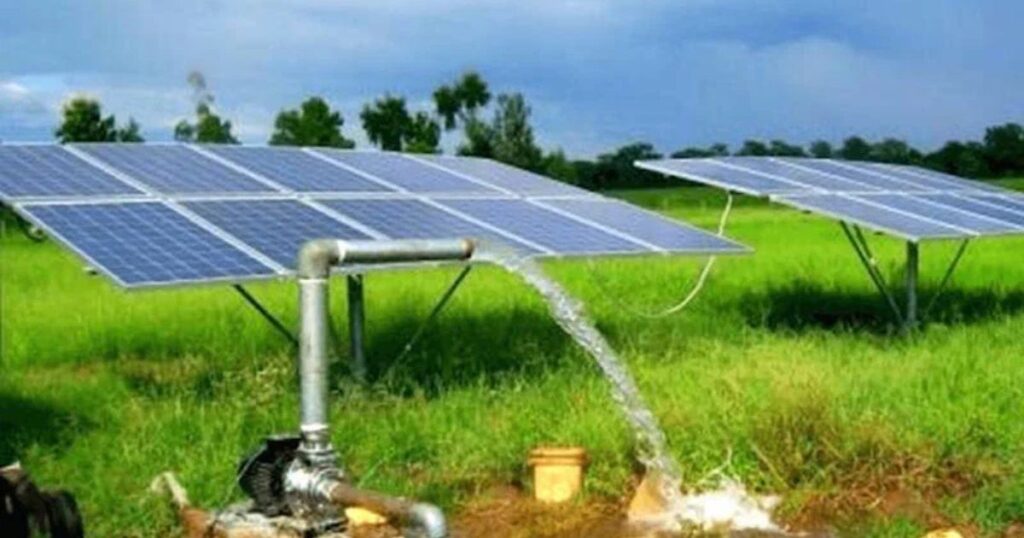 Agrivoltaics is an innovative approach that combines agriculture with solar energy production, offering a range of environmental and economic benefits. By installing solar panels above crops, this system allows farmers to generate renewable energy while continuing to cultivate their land. One major advantage is land-use efficiency, especially in regions where arable land is limited. The shade from panels can reduce heat stress on crops, lower evaporation rates, and improve water retention, making it especially valuable in arid climates.
Agrivoltaics is an innovative approach that combines agriculture with solar energy production, offering a range of environmental and economic benefits. By installing solar panels above crops, this system allows farmers to generate renewable energy while continuing to cultivate their land. One major advantage is land-use efficiency, especially in regions where arable land is limited. The shade from panels can reduce heat stress on crops, lower evaporation rates, and improve water retention, making it especially valuable in arid climates.
Additionally, agrivoltaics can create microclimates that enhance crop yields for certain plants. From an economic standpoint, it diversifies farm income through energy sales, offering greater financial stability. It also reduces carbon emissions by replacing fossil fuel-based electricity with solar power. By integrating food and energy systems, agrivoltaics supports sustainable development, rural resilience, and climate change solar panels for fields mitigation, making it a powerful tool for building a more sustainable future.
Land Use Efficiency
With arable land shrinking due to urbanization and degradation, agrivoltaics maximizes land productivity. A single hectare can produce 100–400 MWh of electricity annually while yielding 70–100% of traditional crop output, depending on the system. This dual output is critical in densely populated countries like Japan, where land is at a premium. In 2023, Japan had over 2,000 agrivoltaic installations, generating enough energy to power 500,000 households while maintaining food solar panels on farm production.
Economic Advantages
Farmers benefit from diversified income streams. Solar leases for agrivoltaic farming provide steady revenue, often $500–$1,000 per acre annually, while crops continue to generate profits. In some cases, energy companies cover installation costs, reducing financial risk for farmers. A 2022 report from the U.S. Department of Energy estimated that agrivoltaic systems could increase farm profitability by 30–50%, making them an attractive option for small and mid-sized farms.
Environmental Impact
Agrivoltaics aligns with global sustainability goals. By reducing irrigation needs, it conserves water, a critical resource in drought-prone areas. The panels also reduce soil erosion by shielding the ground from heavy rain and wind. Moreover, agrivoltaic systems support biodiversity by creating habitats for pollinators like bees and butterflies. A 2024 study in France found that pollinator populations were 20% higher in agrivoltaic fields compared to conventional farms, boosting crop pollination and farming under solar panels yields.
Climate Resilience
Climate change brings unpredictable weather—heatwaves, droughts, and storms—that threaten agriculture. Agrivoltaics offers resilience. Shade from panels protects crops from heat stress, while the fixed income from solar leases helps farmers weather economic losses from crop failures. In regions like sub-Saharan Africa, where smallholder farmers are vulnerable to climate shocks, agrivoltaics could stabilize livelihoods and food solar panels on systematic agriculture farmland.
Challenges and Limitations
Despite advancements in technology and methodology, significant challenges and limitations persist across various domains. One primary concern is data quality—many systems depend on large volumes of accurate, unbiased data, which is not always available. Additionally, technical limitations such as insufficient computational power or system scalability can hinder performance and innovation. Ethical concerns, including privacy, transparency, and algorithmic fairness, also present obstacles that require ongoing attention.
In interdisciplinary environments, communication gaps between experts from different fields can slow progress or lead to misunderstandings. Furthermore, regulatory and legal uncertainties can delay deployment or restrict potential use cases. Finally, resource constraints—whether financial, temporal, or human—can limit the scope and sustainability of projects. These issues underscore the importance of continual evaluation, responsible design, and collaborative problem-solving to overcome barriers and ensure long-term success.
High Initial Costs
Installing solar panels is expensive, with costs ranging from $10,000 to $50,000 per acre, depending on the system. While energy companies or government subsidies can offset this, small farmers may struggle to access financing. Maintenance costs, such as panel cleaning and repairs, also add to the burden. Scaling agrivoltaics requires innovative financing models, like microloans or public-private partnerships, to make it accessible to all farmers.
Crop and Regional Variability
Agrivoltaics isn’t a one-size-fits-all solution. Crops like corn and rice, which require full sunlight, may see reduced yields under panels. Similarly, regions with limited sunlight, like northern Europe, face trade-offs between energy and crop production. Tailoring systems to local conditions—through crop selection, panel height, and spacing—is critical but requires extensive research and experimentation.
Technical and Logistical Hurdles
Farming under panels demands adjustments. Standard tractors may not fit beneath low-mounted panels, necessitating smaller equipment or manual labor. Panel spacing must be carefully designed to avoid shading crops excessively, which can complicate installation. Additionally, integrating energy infrastructure with farming operations requires coordination between farmers, energy companies, and regulators, which can slow farming under solar panels adoption.
Policy and Regulatory Barriers
In many countries, land-use regulations restrict combining agriculture and energy production. Zoning laws may classify agrivoltaic sites as industrial rather than agricultural, triggering higher taxes or permitting hurdles. Subsidies for solar energy or farming often don’t account for dual-use systems, leaving agrivoltaics in a policy gray zone. Streamlining regulations and creating targeted incentives are essential to scale the practice.
Global Case Studies
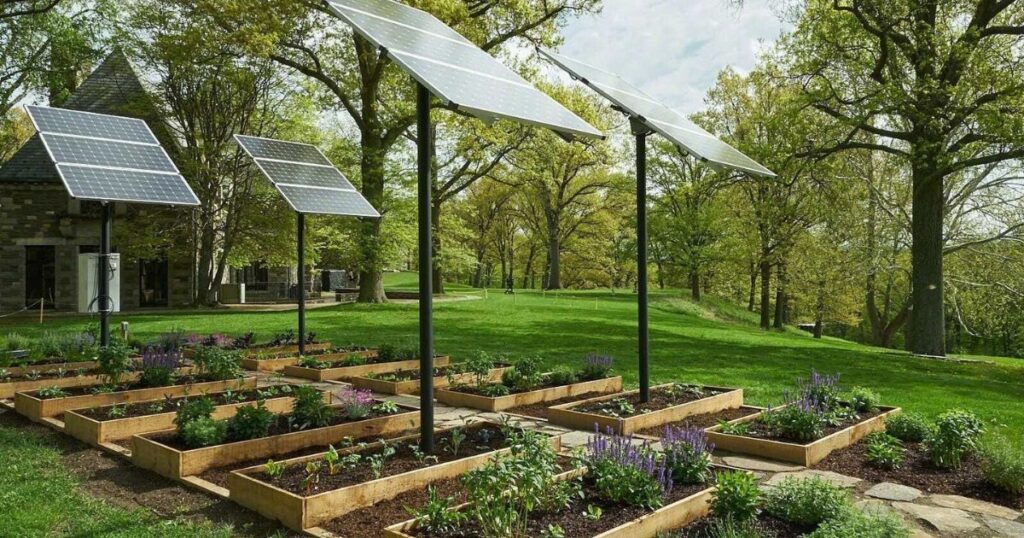 Global Case Studies” offers an in-depth exploration of real-world scenarios from diverse industries and geographic regions, highlighting challenges, strategies, and outcomes across various sectors. This compilation serves as a valuable resource for students, professionals, and researchers seeking to understand how businesses, governments, and organizations adapt to complex environments. Each case provides context-specific analysis, cultural insights, and practical takeaways that encourage critical thinking and global awareness.
Global Case Studies” offers an in-depth exploration of real-world scenarios from diverse industries and geographic regions, highlighting challenges, strategies, and outcomes across various sectors. This compilation serves as a valuable resource for students, professionals, and researchers seeking to understand how businesses, governments, and organizations adapt to complex environments. Each case provides context-specific analysis, cultural insights, and practical takeaways that encourage critical thinking and global awareness.
From sustainable development in Scandinavia to digital transformation in Southeast Asia, these studies illustrate how localized decisions can have global implications. By examining successes and setbacks alike, “Global Case Studies” fosters a nuanced appreciation for the interconnectedness of today’s world and equips readers with the analytical tools to apply lessons in their contexts. Ideal for academic learning, strategic planning, or policy development, this collection bridges theory and practice with real impact.
France: Leading the Charge
France is a global leader in agrivoltaics, with over 1,000 installations by 2025. The country’s 2023 agrivoltaic law incentivizes dual-use systems by offering subsidies and simplifying permitting. A notable project in Piolenc combines grapevines with solar panels, producing 1,200 MWh of electricity annually while maintaining wine production. The shade from panels has improved grape quality by farming under solar panels, reducing water stress, delighting vintners and energy providers alike.
United States: Scaling Up
The U.S. is catching up, driven by federal funding and research. The Department of Energy’s 2021 InSPIRE program has funded 25 agrivoltaic projects across 15 states, focusing on crops like blueberries, alfalfa, and hay. In Arizona, a 2024 pilot project showed that chili peppers grown under panels required 40% less water and yielded 10% more than those in open fields. These successes are spurring investment, with projections estimating 2 GW of agrivoltaic capacity by 2030.
India: Empowering Smallholders
In India, where 80% of farmers own less than two hectares, agrivoltaics offers a lifeline. A 2023 project in Gujarat combines solar panels with mung beans and peanuts, generating 500 kWh per acre while increasing crop yields by 15%. The steady income from solar leases has helped farmers invest in better seeds and irrigation, breaking cycles of poverty. India aims to install 10 GW of agrivoltaic capacity by 2030, supported by government subsidies.
Japan: Innovating in Tight Spaces
Japan’s land scarcity makes agrivoltaics a natural fit. A 2024 project in Chiba Prefecture integrates rice paddies with solar panels, using adjustable panels to optimize light during the growing season. The system generates 800 MWh annually while maintaining 90% of traditional rice yields. Japan’s success highlights how technology and policy can overcome spatial constraints, offering a model for other densely populated regions.
The Role of Technology
Technology plays a pivotal role in shaping modern society, influencing how we communicate, work, learn, and solve complex problems. It drives innovation across sectors—from healthcare and education to agriculture and entertainment—enhancing productivity and improving quality of life. Through advancements in digital tools, artificial intelligence, and automation, technology has revolutionized industries, enabling faster decision-making and global connectivity. It also supports scientific discoveries and environmental sustainability efforts, helping address pressing global challenges.
However, with its benefits come ethical considerations, such as data privacy, cybersecurity, and the digital divide, which highlight the importance of responsible use and equitable access. Ultimately, technology acts as both a tool and a catalyst, redefining human potential and transforming how we interact with the world.
Advanced Panel Designs
Innovations in solar technology are enhancing agrivoltaics. Semi-transparent panels, which allow specific wavelengths of light to pass through, are ideal for crops needing more sunlight. Bifacial panels, which capture light on both sides, increase energy output without compromising crop growth. A 2024 trial in the Netherlands found that bifacial panels boosted energy yields by 20% compared to standard panels in agrivoltaic farming under solar panel systems.
Smart Farming Integration
Artificial intelligence (AI) and Internet of Things (IoT) devices are revolutionizing agrivoltaics. Sensors monitor soil moisture, temperature, and light levels, enabling precise irrigation and panel adjustments. AI algorithms predict crop performance under varying shade conditions, optimizing system design. In a 2025 pilot in California, IoT-enabled agrivoltaic fields reduced water use by 25% and increased lettuce yields by 12% through real-time data.
Energy Storage and Grid Integration
Battery storage systems allow agrivoltaic farms to store excess energy for nighttime use or peak demand periods, maximizing revenue. Microgrids can power on-site farming equipment or nearby communities, enhancing energy access in rural areas. A 2024 project in Kenya paired agrivoltaics with microgrids, providing electricity to 200 households while supporting maize and bean cultivation.
The Future of Agrivoltaics
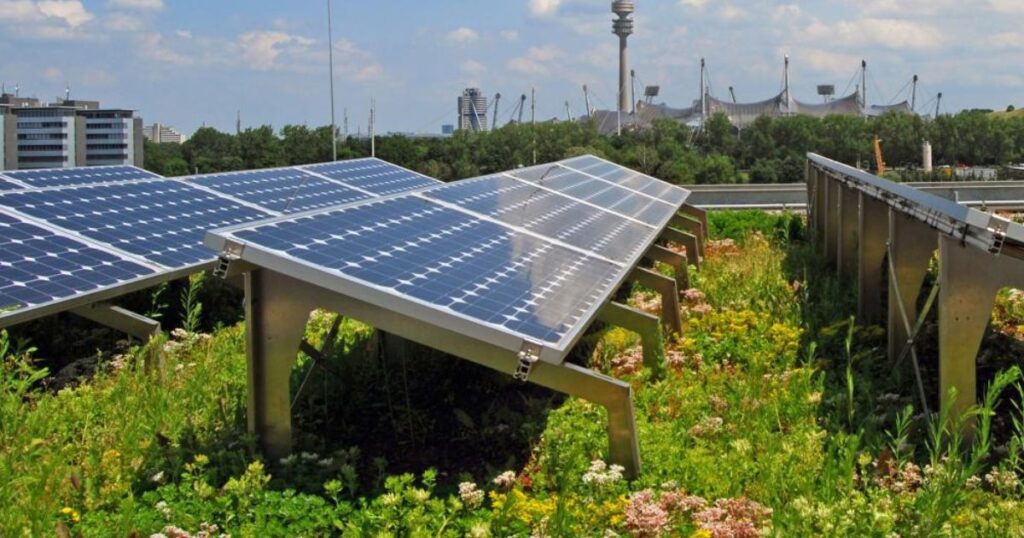 Agrivoltaics, the innovative integration of solar panels with agricultural land use, is poised to transform both farming and renewable energy sectors. By allowing crops to grow beneath or between solar installations, this dual-use approach maximizes land productivity and offers new revenue streams for farmers. As climate change challenges food and energy security, agrivoltaics presents a resilient solution, reducing water evaporation, protecting crops from extreme weather, and generating clean electricity.
Agrivoltaics, the innovative integration of solar panels with agricultural land use, is poised to transform both farming and renewable energy sectors. By allowing crops to grow beneath or between solar installations, this dual-use approach maximizes land productivity and offers new revenue streams for farmers. As climate change challenges food and energy security, agrivoltaics presents a resilient solution, reducing water evaporation, protecting crops from extreme weather, and generating clean electricity.
Emerging technologies, such as adjustable panel systems and AI-powered monitoring, are enhancing efficiency and crop compatibility. In the future, widespread adoption could help decarbonize rural economies, improve food sovereignty, and optimize underutilized land. With supportive policies, research investments, and farmer engagement, agrivoltaics can redefine sustainable land management and energy generation on a global scale. This synergy between agriculture and photovoltaics is not just a technical innovation—it’s a blueprint for a regenerative and climate-resilient future.
Scaling Globally
By 2050, agrivoltaics could cover 1% of global farmland, generating 10 TW of solar energy—enough to meet a quarter of projected electricity demand—while producing food for billions. Achieving this requires investment in research, infrastructure, and policy reform. International collaboration, like the Global Agrivoltaics Alliance launched in 2024, can share best practices and accelerate farming under solar panels.
Community and Equity Focus
Agrivoltaics must prioritize equity. Community-led projects, where farmers co-own solar installations, ensure benefits stay local. Training programs can equip smallholders with the skills to manage dual-use systems. In 2025, a cooperative in Senegal trained 500 women farmers in agrivoltaic techniques, boosting their incomes and food security.
Integration with Other Systems
Agrivoltaics can complement other sustainable practices. Pairing it with agroforestry—growing trees alongside crops—enhances carbon sequestration and biodiversity. Aquavoltaics, combining solar panels with aquaculture, is gaining traction in coastal regions. A 2024 trial in Vietnam integrated shrimp ponds with solar panels, doubling farmer incomes through energy and seafood sales.
Conclusion:
Farming under solar panels is more than a niche innovation, it’s a transformative solution for the 21st century. By harmonizing food and energy production, agrivoltaics tackles land scarcity, climate change, and economic instability head-on. While challenges like cost and crop variability remain, advances in technology, policy, and global collaboration are paving the way for widespread adoption. From French vineyards to Indian smallholdings, agrivoltaic systems are proving that agriculture and renewable energy can thrive together. As we look to 2050, the fields beneath solar panels promise not just crops and kilowatts, but a brighter, more sustainable future for all.
What is farming under solar Panels, also known as Agrivoltaics?
Agrivoltaics is the practice of growing crops or grazing animals beneath solar panels, allowing land to be used simultaneously for renewable energy production and agriculture.
How does this Benefit Farmers?
Farmers can generate an additional income stream from leasing land for solar installations or selling electricity. It also provides protection for certain crops from extreme weather, reduces water evaporation, and can enhance plant growth under the right conditions.
Will Solar Panels Block Too Much Sunlight for Crops to Grow?
No. Agrivoltaic systems are designed to optimize sunlight exposure by spacing panels or tilting them in ways that allow enough light to reach the crops below. Some crops even thrive in partial shade.
What Types of crops grow best under Solar Panels?
Shade-tolerant crops like lettuce, spinach, kale, potatoes, and certain herbs perform well. Research is ongoing to identify the best crop-panel pairings.
Does this System work in all Climates?
Agrivoltaics can be adapted to a wide range of climates. In hot, arid regions, shading from panels can reduce heat stress and conserve water. In cooler or cloudier areas, proper panel configuration is key to maintaining productivity.



